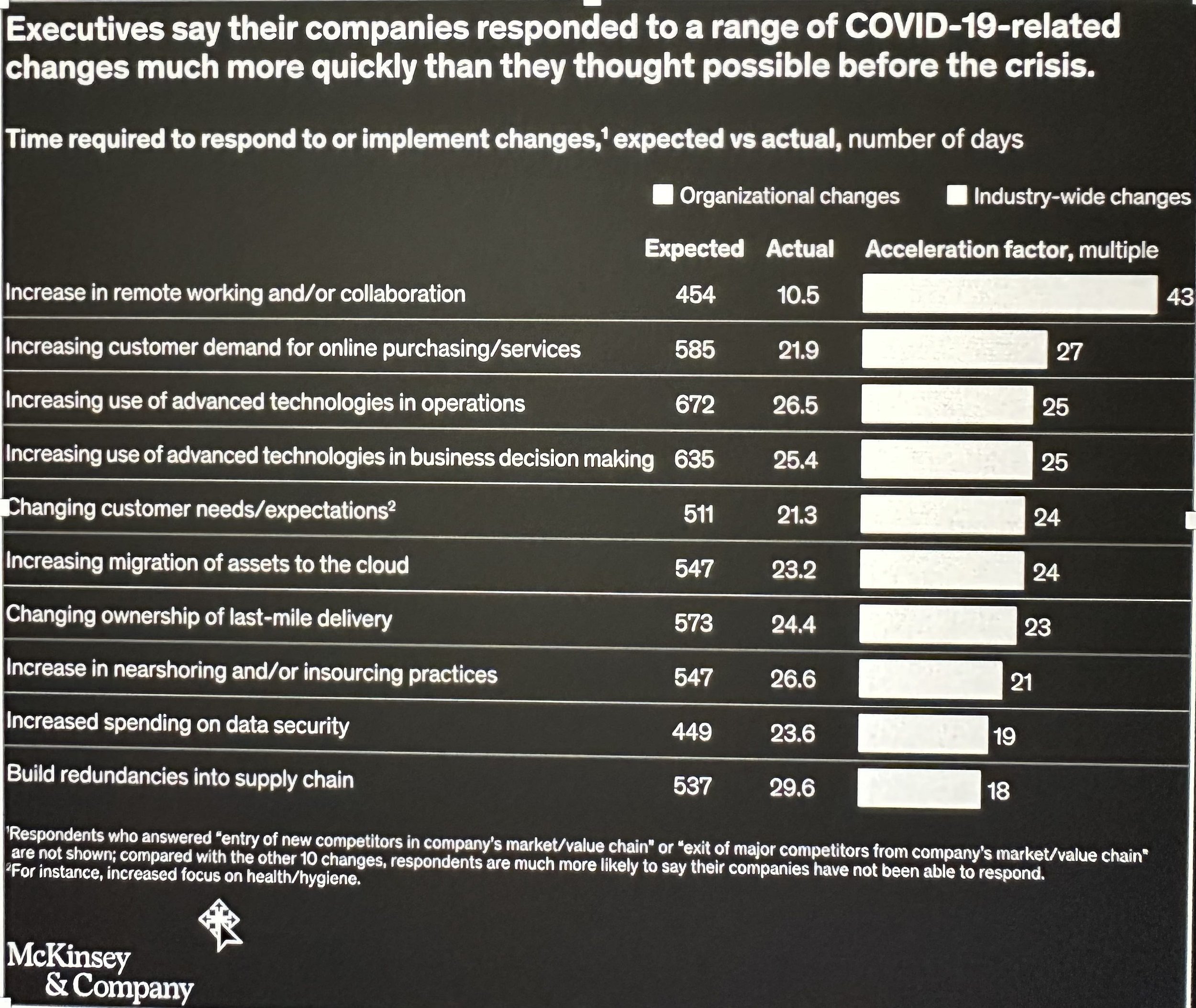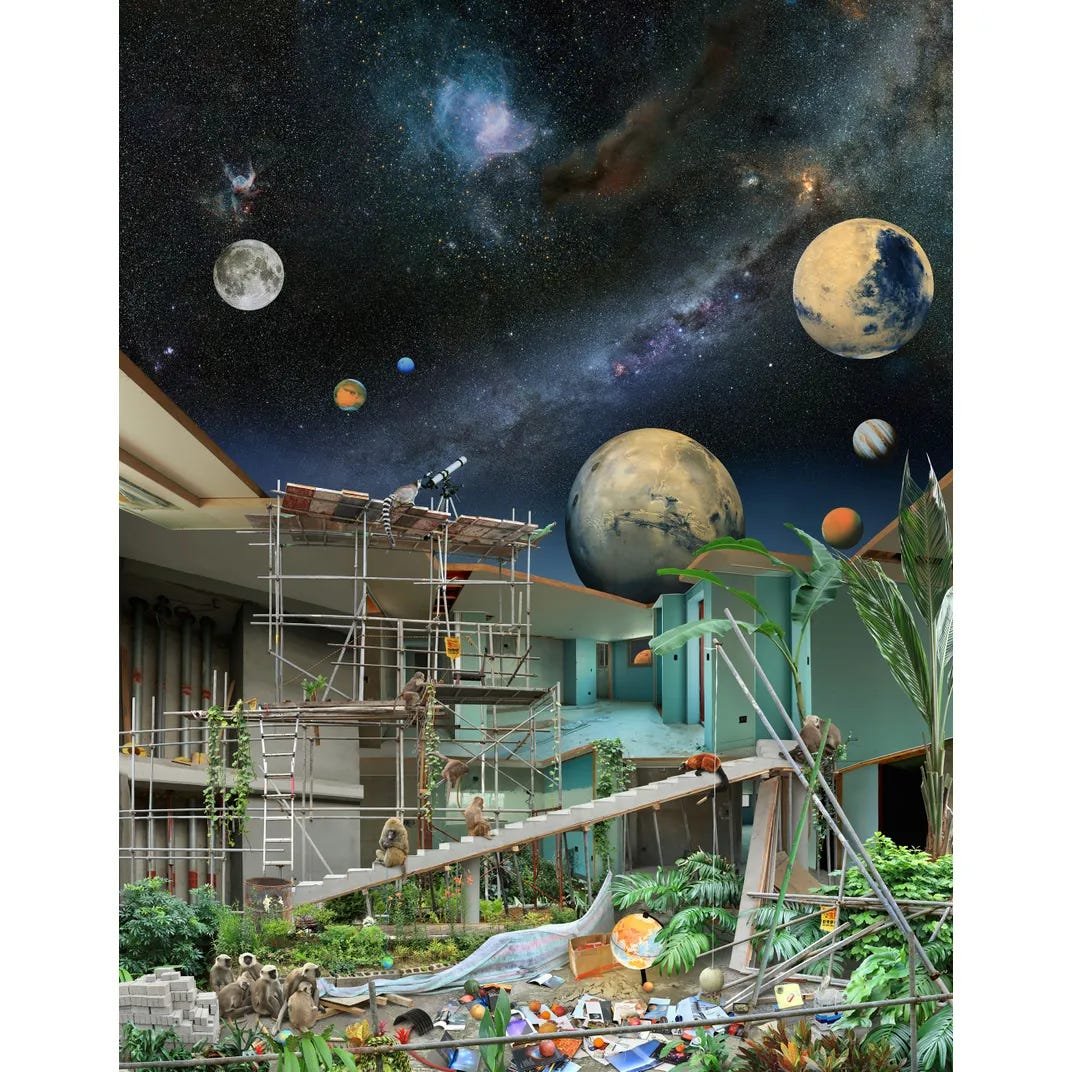Career Bending Times.
Photography by Alex Timmermans
These are career bending times.
A fusion of forces in the forge and furnace of the future that reshape many fundamentals of our careers.
Whether we are early or in the middle or more senior in tenure.
Whether we work for a small, medium, or a large firm.
Whether we are self-employed, a free-lance or a “full-time” employee.
Regardless of our industry, our country, or our expertise.
Photography by Alex Timmermans
The Forces.
There are six forces each of which might have changed the contours of our career which are all occurring at the same time, are intertwined with each other, and are becoming increasingly powerful.
1. Demographic Change: Four generations at work. Major mindset differences between youngest and oldest generations. Aging and declining populations everywhere but Africa. Today the largest increases in working populations are over 60 years old. And 62% of Gen-Z have a side- gig, side-hustle or passion project while working full-time!
2. Technology: 5G, Blockchain, AR/VR, AI, Biotech and much more. Today AI and its impact are resonating everywhere but make no mistake while it might be the “Next New Thing” there is much more coming.
3. Multi-polar globalization: Globalization but with different centers of power including China centric, India centric, Euro centric and US centric zones of influence and virtual borders versus a seamless connected world.
4. Unbundled and Distributed Work: The world of five days in an office will be the minority of service jobs leading to new questions about culture, management, career growth.
5. Work/Life Reset: One long term impact of the 2020 to 2022 trauma was as someone wrote: “And isn’t this the whole point, post-Covid: to actually live your life?” Many people who believed work was life now believe work is an important and key part but just one part of a well-lived life.
6. The melting, decaying, and liquefying of industry shapes and boundaries: With Apple offering 4.15 percent interest on a FDIC insured savings account up to 250,000 dollars that you can fund with one click and loaning you funds from their balance sheet with their Buy Now and Pay Later program they are for all purposes a bank. Walgreen and CVS are shape shifting into not just providing pharmaceuticals but health care. How long before “The New York Times” discontinues its slogan about “all the news fit to print” because it is increasingly a multi-media everything brand which might soon stop printing newspapers?
Each of these forces are intertwined with each other. Modern technology and marketplaces allow for side-gigs and side-hustles and unbundled work. AI powers Biotech and re-configures jobs. New trade barriers move jobs and manufacturing to different countries as does the rise and fall of population.
Photography by Alex Timmermans
The Career Implications.
While the future is often hard to predict one can be quite sure that in the next few years the current waves of change will grow into a tsunami, and everybody will be impacted in some way or the other.
1. We are now going to have 50-year careers: Extended life spans, limited government pensions, incentives for elder people to stay in the workforce, machine enabled work will have us working for multiple decades versus a 30-year career.
2. Life-Long Training and Education: Even three decades into a career well into the 50’s one may need to go back to school, re-skill and re-tool. And the days of saying “We will be retired before all these new things happen” will not be realistic. Investing in continuous learning will be key to stay relevant.
3. We will increasingly be working like gig workers and there will be many other changes to the design of organizations: A job will not be a title, a position and a static role but a constantly changing number of tasks, outcomes and deliverables In a globalized and connected marketplace of unbundled and distributed work we will all become gig workers even if we spend long time in a firm since all firms will become increasingly agile and connected, looking to put the best people on the most appropriate tasks very much like the way Hollywood or TV production works.
4. We will be work in tandem with machines: Almost every job will become AI or Web3 immersed or infuses with some other technology. The productivity increases of modern technology will mean no one without modern technology will be able to compete.
5. We will work in smaller and delayered companies with many of us operating as “Companies of One”: a) AI software, b) Platforms that enable access to marketplaces and talent ( Shopify, Fiver) , c) a need for shapeshifting agility as categories re-invent themselves ( Finance, Auto, Healthcare, Education at a minimum which account for half of US GDP), d) a demand for flexible cost structures in a high velocity world, e) a work-force where free-lance workers are greater than full-time workers (2025 in the US) and f) scar-tissue of over hiring (see tech and media companies today) will significantly reduce the size of most companies, eliminate multiple layers and focus on experts and deliverables versus generalists and process.
6. Leaders and Coaches and Learners versus Bosses and Manager and Know it Alls: In this new world people will likely value, ask for and measure three things:
a) what does an individual help make, build, ship, change or impact?
b) what value do we add to the machine or how do we collaborate with other people or plug into a role on a project so that 1+ 1=3 ?
c) what creativity, vision, empathy, or imagination do we bring to inspire and grow people and business ?
The key will be how one can lead, train, and grow talent to unleash their potential.
The big corner offices, the gauntlet of handlers, receptionists, and other awe-inspiring fear mongering scaffolding of the pre-2020’s will all be seen as the crutches of the insecure and the fearful causing most talent to rapidly re-route around such blockages and blockheads.
People’s “zone of influence” and “zone of impact” will be far more important than our “zone of control” or “size of kingdom”.
Photography by Alex Timmermans
Re-inventing and Staying Relevant.
A complete re-imagining and re-thinking is underway which is why all of us feel some combination of fear, challenge, excitement, and even horror!
The drumbeats of a changing reality are beating in the marrow of our blood even if we do not wish to listen to their forceful thump-thump…
We will all need to bend ourselves into new forms, skills, and shapes.
A few keys to remaining relevant will be:
a. Plan for the long term: Plot careers over phases recognizing different eras as well as our own differences as we age with a look both ahead and behind. Read 12 Career Lessons a distillation of my learnings on re-inventing over time.
b. Build expertise. Hone a craft. Be known.Learn and earn a niche or niches. Have a voice and learn to tell a story. Read Career Turbocharging for an exercise if you are looking for a job, thinking of switching jobs or re-inventing yourself and a job.
c. Do not outsource your career growth to anyone else:Be responsible and control the upgrading of your mental and skill operating system to keep on learning.Here is one way: Learning to learn.
And here is one page with thoughts on a dozen topics to thrive in the future you may wish to bookmark. Look at Section 8, 9 and 10 in particular.
It will be a career bending time.
Which is far better than a career ending time!
On Purpose.
Ipsos publishes an award-winning strategic foresight magazine called “What the Future” . Matt Carmichel, What the Future editor and head of the Ipsos Trends & Foresight Lab, recently spoke to me for an article about Purpose which this post is built on.
What’s the state of purpose today?
There are three ways to look at it.
The first is that Purpose is a core differentiator. A survey by Deloitte indicates the following
“Purpose-oriented companies have higher productivity and growth rates, along with a more satisfied workforce who stay longer with them.5 Our research shows that such companies report 30 percent higher levels of innovation and 40 percent higher levels of workforce retention than their competitors.6 While traditional trends might dominate purchasing behavior, new opportunities exist to connect with customers through purpose.
In 2019 consumer survey showed that price and quality remain the biggest factors driving customer decisions.7 However, many of the same respondents (55 percent) believe businesses today have a greater responsibility to act on issues related to their purpose. Those failing to do so risk being displaced by purpose-driven disruptors. For example, Unilever’s 28 “sustainable living” brands (i.e., brands focused on reducing Unilever’s environmental footprint and increasing social impact) such as Dove, Vaseline, and Lipton delivered 75 percent of the company’s growth and grew 69 percent faster on average than the rest of its businesses in 2018 (compared to 46 percent in 2017).8 Soap, petroleum jelly, and tea are everyday household essentials, but by promoting sustainable living, these products became differentiated as they embody the company’s purpose.”
It is interesting to note that Unilever has not done well recently and changed management which make many believe that purpose can be overplayed.
On “What Next?,” a podcast I host we recently had two different guests talk about purpose and each provided a different perspective.
One was from Thomas Kolster who basically said, “Forget everything you know, about brand purpose.” His basic belief was that businesses are now trying to position themselves as heroes, but they're not heroes. Customers are heroes and they say, “This is my purpose.”
This second perspective is yes purpose is important but forget brand purpose and align with customer purpose.
The other was from Steve Harrison who believes that purpose is over-hyped, that companies have forgotten that they exist to make things, sell things and create jobs. Anything that makes them not remember they're providing jobs, selling things, and making things and instead come up with social concoctions means they have lost the plot.
This third perspective is purpose is bunk. Make things. Create jobs. Ship things and stop all the mumbo-jumbo.
Why purpose is important but needs to be nuanced and authentic.
For most firms reality lives between these perspectives.
Purpose is important because it is one of the “whys” that Simon Sinek says a company needs.
Purpose is also important to attract and retain talent.
People are very interested in what the purpose of the company is, even if the purpose is “We make great products.”
Many people are now looking not just to join a company not for money, fame or power, which is important, but for companies to have purpose, values and connections.
But a company should be very clear that when they are identifying a purpose, it has something to do with their industry.
If it sounds bombastic it will bomb.
Authenticity is key which means tight and believable scope versus “we are here to save the world” that gets everybody who is in the real world either rolling their eyes or shrieking with laughter.
Businesses and Brands are stepping into an unfortunate void.
People are looking to brands and companies to solve problems because they have decided to give less credence to media and government.
If media and government did their jobs, we wouldn’t look to brands and CEO’s to fill in!
The purpose trend and the need for CEO’s to increasingly take positions way outside their business and expertise is due to a crisis of leadership.
A breakdown of trust and a refusal to see the world as it is.
If leaders actually led, which means identify reality, fixing problems, and delivering products and services, people would not say, “What about purpose?”
That is their purpose.
Fix problems. Think long term. Look after people. Ship product. Build infrastructure. Create jobs.
Why Purpose is hard.
Often it is Ben and Jerry or Patagonia or Unilever that are trotted out for case studies.
There are many other examples too but not too many that resonate and ring true because it is difficult.
Purpose is principles.
If you're principled, you’re going to do things that will potentially hurt your career, hurt other people, or hurt financial performance because you decide to say, “That doesn't fit my principles.”
Those brands take a stand and the stand pisses off certain people.
What a lot of companies today are doing is adding purpose because they don’t want to piss off people, which is the exact opposite of what purpose is.
Purpose is taking a stand!
But too often it is a thin veneer of paint on the surface and and not deeply intertwined into the internal brand and company architecture or culture.
Areas that brands can align with which are critical but not politically fraught.
There are three places that brands can help that aren’t politically driven.
Helping people grow old: All over the world except for Africa every country is aging fast. The elderly or the “seasoned” in many countries have many challenges from companionship to the need for medicines to financial constraints.
Everybody regardless of one’s political affiliation, sexual preference or gender identity is going to grow old.
Helping people who are hungry: Organizations like Feeding America to local Soup kitchens to Food banks to School programs all serve humans in need. People in need. Regardless of ones beliefs.
Helping people learn: Brands and companies have great resources not just in money but the talent in the companies, technology and much more. Today like never before learning is key. And learning can be everything from internships to mentorship to coaching and much more. Most countries and areas are struggling with education which in many cases is too expensive, too degree oriented and too exclusionary. Imagine what any company can do in their markets to lift peoples skills which helps both the people and the company by having more people to hire.
What will purpose look like in the future.
Often today purpose is like soufflé at a fancy restaurant. It's basically puffed sugar like expensive candy floss. And a firm often has many purposes all different flavors of candy floss.
The future will be more single minded and unified purpose that links to your product, show how you look after your employees with it and shows customers that because of that they will feel better about your product or service.
Brands are built today on three criteria.
One is delivery of benefits. If you clearly can do something particularly well, that's what you're supposed to be doing. Authentic. Real. Aligned with the business.
The second is purpose will require one to have happy employees. Companies who do not look to create joyful employees will not be believed about some mumbo jumbo purpose. Who cares how you source your product or how you will save the climate when you care and look after your employees?
The third is, is the purpose measurably helping people feel better about your product or service?
The future of purpose, highly measurable and very much aligned with the company’s customers, employees and community.
Photography by Rishad Tobaccowala
Creative Cultures.
Photography by Michele Sons
In 2010 Kat Gordon was the rare creative director who was a woman.
3 percent of creative directors were women then and almost no one of color.
Kat decided to do something about it, and she began The 3% Movement built on the belief that Diversity=Creativity= Profitability.
Ten years later after a decade of conferences and other initiatives nearly 30 percent of creative directors were women and while there is still a way to go Kat re-imagined and re-invented the movement to be even more community and peer to peer driven.
Kat was the latest guest on What Next? where she discussed how to be “Creative about Creative Leadership”. The conversation is applicable to any company , individual or leader regardless who might be grappling with culture, creativity, combining AI with humans, the future of the workplace and much more.
Photography by Michele Sons
Creative cultures are communities of belonging held up by trampolines of trust and creative entrepreneurship.
For decades companies have run as hierarchies.
The boss has been the parent and the employees the children.
It was important to gain favor with “dad” to earn rewards and to avoid punishment.
There was the “Sun-King’ at the center with some others in the royal court and most people were after thoughts on whom no light shined.
Changing demographics, new mindsets, enabling technology and distributed work is moving power from the center to the edge.
Stars can shine anywhere.
Creativity is increasingly about teamwork…note how entire teams take the stage at Cannes.
It is about community and a peer orientation where taking risks and speaking up and making mistakes are supported by trampolines of trust versus encrusted with jagged cliffs of death.
It requires Creative Entrepreneurs who build, create, sculpt and design not just new work but new organization and ways of working.
We not only have to re-think creativity but creatively re-think the creative organization.
Photography by Michele Sons
Creative cultures like nature constantly evolve and adapt and constantly ingest, incorporate, and build on new technologies.
The 3% Movement changed the way they work, and their focus based on new technologies, new ways of working and new challenges.
Nature evolves. We are on the 16th operating system of the Apple iPhone. Culture changes.
Creativity by definition is about the new, the fresh, the insightful, the not done before!
Moving hearts and minds, building brands and telling stories have changed as we moved from word to audio to film to digital to multi-media.
Modern technology of prompt to words (GPT-4), prompt to image (DALL·E 2, Mid-Journey, Stable Diffusion) or prompt to video (Runway ML) are already being leveraged by the creative community to great effect in three ways:
a) Enhanced Productivity: The best creative talent is overworked and often burned out. These new technologies save time and become super assistants to them in eliminating much rote work. So many creatives will benefit from tools to help them become more productive.
b) Idea Catalysts: Now instead of staring at blank sheet of paper to start a project we have starter ideas, templates, first drafts and initial imagery to build on, add our unique value to, correct and enhance. New options will unleash new worlds of creativity.
c) New Paints and Canvases: Today Creatives have a canvas of the new immersive worlds of gaming driven by Unreal Engine, 3D frontiers of creativity where the real and virtual blend such as AR/VR as well as Mongrel Media where one can embed and combine commerce and video and much more, All of these are opening massive new universes for creativity which would not have been achievable or scalable without the new AI tools.
While change might be difficult, irrelevance is worse and talent will adapt and incorporate the new tools. Some jobs will go, and others will come but if “life is short and art is long”, creativity and the creative community will not just endure but thrive.
Photography by Michele Sons
Companies that believe in diversity should also allow diverse ways of working.
The future of how work will be done in an unbundled and distributed era while operationally challenging is creatively exciting!
Creativity is connecting dots in new ways.
Ideas can occur anywhere whether it is on a walk, in a shower or while grocery shopping.
In person interaction can happen at conferences, restaurants, bars, learning events, training programs as well as the office.
It is time for companies to be brave and not go back to the safety of what was one tried and true.
Different people have different ways they prefer to work.
Different levels of expertise need different environments and support.
Instead of being like the Mandalorian and mandating “this is the way” leaders should follow the wise words of The Lawrence of Arabia’s recognizing that “nothing is written!” and experiment with different ways.
Companies that develop and integrate a portfolio of ways of working in ways that are balanced and unified but with built in flex are likely to attract, unleash and turbo-charge creativity.
They will create cultures of innovation and potentially gain long term competitive edges.
Diversity of working styles is also diversity and now is the time for companies to try different models and then offer some subset of choices to talent.
Photography by Michele Sons
A significant number of future creative leaders will be introverts and empaths.
When Susan Cain wrote the best-selling book Quiet: The Power of Introverts in a World That Cannot Stop Talking she noted that half of the population described themselves as introverts.
But today in many industries 80 percent or more of the leaders are extroverts.
This is changing and recent developments will turbo-charge the rise of introverts and empaths so that the leadership population is more like the general population.
There are many reasons for this rise beginning with the rejection of toxic or bullying or command and control cultures. People today have just too many options to put up with nonsense. People leave bosses much more than they leave companies.
More importantly the world of unbundled and distributed work is introvert and empathy friendly since many office environments with their noise and “war-rooms” are not conducive to these personalities who prefer quiet and reflection to get things done.
More importantly in a world of Zoom everyone can be “seen”. The boss has the same square footage on Zoom as the lowest ranked employee There is no corner office equivalent of Zoom where someone’s tile is bigger (probably one reason some bosses want people back to the office).
The loud and the quiet are on equal footing.
People are more likely to speak up. Content quality, conversational ability, creativity inspired, and the community minded can thrive.
And in a world where the left-brain tasks will be increasingly done by machines there will be a great demand for empathy, emotion, and humanity to work in tandem with the machines.
Remember the Memorex ad that asked “Is it live or is it Memorex? and the orange juices that promise they are “100 percent pure squeezed”
Soon just liked hand crafted, artisanal, and traditional earns a premium price, we will be promised “100% human” while we wonder whether “Is it human or is it AI?”
For companies focused on diversity it is important to remember that diversity includes people with different personalities.
In a brave new world lets be creatively open, embrace diversity and be organizationally brave.
The New World of Work.
In March of 2023 the headline of a cover story in the Wall Street Journal shrieked “ Work from Home Era ends for millions of Americans”
The very same day another headline in Axios read “ Remote work is starting to hit office rents”
On closer analysis, the Wall Street Journal article explains why their headline while true does not reflect the nuance in the data which indicates that while fewer people are working fully remote, and more employees are coming back to the office for a few days a week, in many white collar and information driven industries three years after the pandemic significant portions of work is no longer done in the office.
Which explains why in major cities such as New York and San Francisco which have many white collar and information technology workers and where commute is expensive office rents are declining by 15% (New York) to 30% (San Francisco)
For instance, the article noted:
“Remote work remained common last year in some jobs that traditionally were done in an office. In the information sector, which includes tech and media firms, 67.4% of establishments said their staff worked remotely some or all the time. In the professional and business sector, which includes law and accounting firms, the share was 49%.”
And the share of establishments that were fully remote rose slightly last year, to 11.1% of establishments from 10.3% in 2021, the Labor Department said. In the information industry, that share increased 4.8 percentage points, to 42.2%.
In February 2023, 27.7% of total days worked were from home, after holding steady at an average of 30% each month in 2022, according to research by economists Jose Maria Barrero of Instituto Tecnológico Autónomo de México, Stanford’s Nicholas Bloom, and Steven J. Davis of the University of Chicago. The share is down sharply from May 2020, when around 60% of days were remote but still more than five times the rate that prevailed before the pandemic.
And the article notes when it comes to fully remote work it “isn’t likely to entirely disappear.
Some 13% of current job postings are for fully remote positions, according to staffing firm ManpowerGroup. That is down from 17% in March 2022 but well above the pre-pandemic level of 4%.”
As Covid recedes of course retail and other workers will go back to work and so will many white collar and info tech workers for some of the time.
There is a great benefit to in person interaction for some of the time.
But world has changed in so many ways that there is no going back to 2019.
Here are just 6 of many changes:
1. Significant investments in digitizing workplace means companies are now structured to service customers and support employees in different ways.
A Mckinsey study showed that within six months of offices closing companies had accelerated their digitization by several years. As a result, companies have been built to have their employees work from anywhere and support their customers in any way.
2. Improved productivity because of hybrid work.
The half of the workforce that have jobs which have allowed for remote work have reported that they are more productive in a hybrid versus a full time in the office environment. This is reflected in a three year tracking study from the Conference Board that indicates that as companies and individuals get their mind around the reality that the future of work for many industries is hybrid and they create processes and structure around this people are becoming more productive.
In addition recent study at the University of Birmingham, which surveyed 597 managers, has shed light on how managers’ attitudes towards the hybrid work model have changed as a result of the pandemic. Surprisingly, the findings reveal an increasingly positive outlook on the benefits of remote and flexible working.
The study found that 52% of managers agreed that working from home improves concentration, 60% said it improves productivity, and 63% stated it increases motivation. This is a significant shift in attitude, as there has long been a perception that working from home can be a distraction, leading to a lack of productivity and motivation.
The study also revealed that more than seven in 10 (73%) managers felt that giving employees flexibility over their working hours increased productivity, while 60% said the same for working from home. This suggests that managers are starting to recognize that giving employees more control over when and where they work can lead to better performance.
The emerging reality is that in-person interaction is critical for many aspects of culture, people growth and quality control.
The debate is not between not coming into the office or coming into the office most of the week. Rather is is how to combine the benefits of in-person with those of distributed work.
And to ensure that in office is really about in person versus a form of control, absence of trust, input monitoring and the inability of a management class to learn to be leaders versus bosses.
3. Companies have become much more flexible about hiring workers from anywhere according to the Conference Board which benefit both employee and company.
Before the pandemic, 46 percent of surveyed HC leaders indicated that their organizations were not willing to hire virtual employees, and 8 percent were willing in the US or globally. Now 49 percent are willing to hire 100 percent virtually, a sixfold increase.
The flexibility enables not only makes it easier to attract talent but also gain more diverse talent and reduce costs by recruiting from a much larger pool and cutting certain costs such as real estate.
4. People have a new mindset which no longer put up with toxic cultures or burn out.
The Great Resignation according to MIT Sloan is driven by people were leaving not for higher pay somewhere else but fleeing from a toxic culture and poor management
A toxic corporate culture is by far the strongest predictor of industry-adjusted attrition and is 10 times more important than compensation in predicting turnover.
MIT’s analysis found that the leading elements contributing to toxic cultures include failure to promote diversity, equity, and inclusion; workers feeling disrespected; and unethical behavior.
The MIT analysis enforces a recent Harvard Business Review article, where 76% of the workers polled believe that employees will be more likely to prioritize lifestyle (family and personal interests) over proximity to work and will pursue jobs in locations where they can focus on both—even if it means taking a pay cut.
5. New Approaches to Management and New Management Skills focused more on leading and looking after people versus managing and processing work.
There are significant challenges to managing in todays unbundled and distributed workplace.
I asked GPT-4 if management was necessary in a world of unbundled work and here is what it said:
“Covid-19 has not necessarily reduced the need for management, but it has changed the way management functions in various organizations. The pandemic has forced organizations to adapt quickly to new ways of working, such as remote work and virtual collaboration. This has led to shifts in management practices and priorities, including:
1. Emphasis on digital transformation: With remote work becoming the norm, organizations have had to invest in digital tools and platforms. Managers need to stay updated on the latest technologies and implement them to streamline work processes and communication.
2. Communication and engagement: Managers have had to adapt their communication styles to ensure clear and effective communication within remote teams. This has led to an increased emphasis on video calls, regular check-ins, and virtual team building activities.
3. Focus on employee well-being: The pandemic has highlighted the importance of mental and emotional well-being. Managers have been tasked with providing support and resources to help employees cope with stress, anxiety, and other challenges that come with remote work.
4. Adaptability and flexibility: Managers have had to be more agile and adaptable in navigating through the uncertainties brought about by the pandemic. This has included adapting work policies, redefining goals, and rethinking strategies to align with the changing business landscape.
5. Reskilling and upskilling: With the pandemic accelerating digital transformation, managers have had to ensure their teams are equipped with the necessary skills to adapt and remain competitive.
While the pandemic has not reduced the need for management, it has shifted priorities and required managers to develop new skills and approaches to effectively lead their teams in a rapidly changing environment.”
If managers need to manage better they will always have a co-manager in AI!
6. The Future for most white-collar companies will be a blend of in-person and unbundled distributed work combining high-tech and high-touch.
When people believe that things are going back to the way they were pre-pandemic in addition to the facts that indicate otherwise one must remember that people’s minds are like champagne corks. They swell and they do not fit back into the bottle.
Three years of working differently combined with widespread availability of technology to work remotely across every company and industry means the future will not fit in the containers or the mindsets of the past.
Here are three reasons that even businesses who want to have employees spend 3 days or more in the office because they believe training, culture and quality require it they will not force things back to the way they were:
1. Larger pools of talent: Allowing for some or primary unbundled and distributed work allows companies to recruit from a far larger pool of talent. This is not just because they can hire from any market but also, they can recruit mothers looking after children, people not able to commute and people who want to work part time. In addition they can access their entire global workforce moving demand to where there have staff versus having to hire staff in one market while cutting staff in another. No company can compete by reducing its flexibility to access the best available talent pool.
2. Reduced costs: Remote work enables cost reduction not just because one can hire form a larger talent pool but there will be less travel costs, less real-estate costs and less severance if work can be moved between markets. In addition there will be fewer overhead costs because now more of the work force can be fractionalized, contracted or hired part time.
3. Future Ready: We have entered the Third Connected Age of Technology where AI, AR/VR, 5G and Blockchain all will turbo charge distributed work and change the profile of organizational design.
The future companies will re-aggregate talent recognizing the future of work will be around gigs which require different expertise coming together at different times. This talent will work alongside tech enabled machines and will need to continuously grow and hone its skills,
It is unlikely returning to 2019 way of working will suffice for this new world.
Architect. Sculpt. Hone.
Photography by Christian Fletcher
These days waves of change, seas of surprises and tectonic tsunamis are transforming our landscapes on an almost weekly basis.
Rapidly accelerating AI.
Bank failures.
Tech and other layoffs.
China Cards. Russian Wars. Indian Nationalism.
And the list goes on.
Doom scrolling. Hyper ventilating. Dramatic emotions. Screeching headlines.
All of these are understandable human reactions as we grope to find a place to stand in rapidly shifting sands.
But nothing gets better at the end of the venting of feelings though we may feel better as we rail against a world out of control.
Rather let us embrace, respect and focus our feelings to align with the forces of change
It is a time to use the fuel of feelings to architect, to sculpt, and to hone ourselves so we can continue to thrive in the future.
It’s more up to ourselves than we think.
Photography by Christian Fletcher
Architect.
“The way we spend our time defines who we are.” Jonathan Estrin
One way to gain control is to architect one’s week in ways that time and its vagaries do not toss us around.
Consider setting aside an hour a day or seven hours a week to feed each of one’s physical, mental, emotional systems.
Physical operating system: A long walk or exercise.
Mental operating system: Learn or read or watch or do.
Emotional operating system: Connecting with friends and family. Helping others.
Architecting one’s day to feed each of the operating systems is independent of income, employment status, or country in that they do not cost much if anything.
And no day where one has learned something, connected with somebody, and helped the body can be deemed a wasted day.
3 hours a day, 21 hours a week sets the foundation for the other 147 hours in mood, tempo, and control.
Build tomorrow by architecting today.
Photography by Christian Fletcher
Sculpt.
“Every block of stone has a statue inside it, and it is the sculptor’s job to release it” Michelangelo.
Every individual has one or more talents, and it is our job to find, feed and sculpt these talents.
Today we are increasingly in a world of builders, makers, creators, inventors and in sculpting something special out of raw materials is a way to find flow and make and leave one’s mark.
It may be writing or photography or video or writing code, cooking a meal, investing in a relationship, building a company or many other things but transforming and building is both an anti-dote and a homage to a transforming world.
We transform and are not just transformed.
Build things. Make stuff. Create something .Unleash potential.
We can release the statue within us or help others find the statue within them.
Photography by Christian Fletcher
Hone.
“To hone my voice, I read everything, from books to cereal boxes, three times: once for fun, the second time to learn something new about the writing craft, and the third time was to improve that piece.” Amanda Gorman
In a world of change we must hone ourselves to align with change since change does not care to adjust to us.
Honing through iteration, upskilling, re-inventing, and many other ways of enhancing excellence of craft.
For many of us in the coming years it will be how to incorporate, build on, extend, and leverage AI as a tool, enabler, extender, and idea generator for our work.
How to find new ways to communicate and connect as Augmented Reality and Virtual Reality enable new canvasses.
Machines will replace people who do not hone their craft to incorporate machines but will not replace talent who hone skills to incorporate and complement machines.
We cannot control or impact what a world leader may do, what shocks may come or what others may have planned but we can twist ourselves and our skills into new shapes to make sure that we bend with the arc of the future and are not broken.
The future may not fit in the containers of the past.
But by architecting, sculpting and honing we will thrive in the container called the future.






























